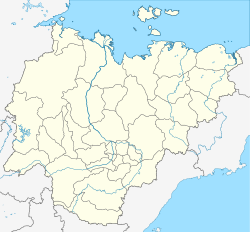Verkhoiansk
| Verkhoyansk (in English) Верхоянск (Russian) Верхоянскай (Yakut) |
|
|---|---|
| - Town - Town under district jurisdiction |
|
 Pole of Cold in Verkhoyansk |
|
 Location of the Sakha (Yakutia) Republic in Russia |
|
|
|
|
|
|
|
|
|
|
| Administrative status (as of June 2009) | |
| Country | Russia |
| Federal subject | Sakha Republic |
| Administrative district | Verkhoyansky District |
| Town | Verkhoyansk |
| Administrative center of | Town of Verkhoyansk |
| Municipal status (as of April 2012) | |
| Municipal district | Verkhoyansky Municipal District |
| Urban settlement | Verkhoyansk Urban Settlement |
| Administrative center of | Verkhoyansk Urban Settlement |
| Statistics | |
| Population (2010 Census) | 1,311 inhabitants |
| Time zone | VLAT (UTC+10:00) |
| Founded | 1638 |
| Town status since | 1817 |
| Postal code(s) | 678530 |
| Dialing code(s) | +7 41165 |
| on | |
| 2010 Census | 1,311 |
|---|---|
| 2002 Census | 1,434 |
| 1989 Census | 1,883 |
| 1979 Census | 1,709 |
Verkhoyansk (Russian: Верхоянск; IPA: [vʲɪrxɐˈjansk]; Yakut: Верхоянскай, Verxoyanskay) is a town in Verkhoyansky District of the Sakha Republic, Russia, located on the Yana River near the Arctic Circle, 92 kilometers (57 mi) from Batagay, the administrative center of the district, and 675 kilometers (419 mi) north of Yakutsk, the capital of the republic. As of the 2010 Census, its population was 1,311. The town holds the Guinness world record for the greatest temperature range on Earth: 105 °C (189 °F).
Cossacks founded an ostrog in 1638, 90 kilometers (56 mi) southwest of the modern town. The ostrog's name "Verkhoyansky", roughly translating from Russian as the town on the Upper Yana, derived from its geographical location on the upper reaches of the Yana River. In 1775, it was moved to the left bank of the Yana River to facilitate tax collection. It was granted town status in 1817. Between the 1860s and 1917, the town was a place of political exile, with some of the more prominent exiles including the Polish writer Wacław Sieroszewski, as well as Bolshevik revolutionaries Ivan Babushkin and Viktor Nogin.
...
Wikipedia


